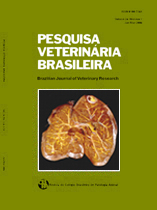 |
|
|
|
Year 2009 - Volume 29, Number 04
|

|
Aspectos histológicos e morfométricos dos testículos de gatos domésticos (Felis catus), p.312-316
|
ABSTRACT.- Silva C.A.O., Perri S.H.V., Koivisto M.B., Silva A.M., Carvalho R.G. & Monteiro C.M.R. 2009. [Histological and morphometric evaluation of the testes of cats (Felis catus).] Aspectos histológicos e morfométricos dos testículos de gatos domésticos (Felis catus). Pesquisa Veterinária Brasileira 29(4):312-316. Curso de Medicina Veterinária, Faculdade de Odontologia, Universidade Estadual Paulista, Rua Clóvis Pestana 793, Araçatuba, SP 16050-680, Brazil. E-mail: monteiro@fmva.unesp.br
This paper deals with a comparative histologic and morphometric study of the testes of domestic cats distributed into two groups: Group 1, cats until 1 year of age, and Group 2, cats over 1 year. It was found that: (1) at 4 months of age the seminiferous tubules were poorly developed, appeared as seminiferous cords without lumen, lined by a low epithelium, and showed undifferentiated Sertoli cells and scarce interstitial tissue; (2) at 5 months the seminiferous tubules began to differentiate with increase in tubular diameter and lumen, the other tubular structures remaining similar to those previous referred; (3) at 6 and 7 months of age spermatocytogenesis began to appear, Leydig cells were large, polyhedral in shape, with vacuolated cytoplasm and clear nuclei, resting on a sparse interstitial tissue with few blood vessels; (4) 1-year-old cats showed testicular histological features of an adult animal, had seminiferous tubules of large diameter and high seminiferous epithelium with small lumen, and Leydig cells of different sizes, with polyhedral shape, vacuolated cytoplasm, clear nuclei and evident nucleoli resting in a sparse interstitial tissue with some blood vessels; (5) in Group 1 the average diameter of the seminiferous tubules was 160.58µm, and 185.94µm in Group 2; (6) the height of the seminiferous epithelium was 49.51µm for Group 1 and 63.29µm for Group 2; (7) the largest measures of the analyzed parameters were found in animals of Group 2, with functional reproductive organs. |
| |
|
|
| |
|
 |